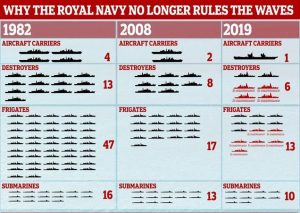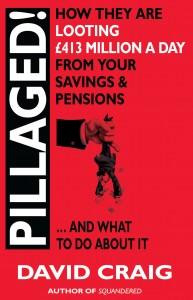(Tuesday blog)
A Royal Navy farce?
When Britain ‘hijacked’ an Iranian oil tanker, the Iranians helpfully informed us that they would ‘hijack’ one of ours in return. Given this warning, ordinary people might wonder why our Royal Navy failed to react to protect our shipping.
As the Royal Navy now belatedly scrambles around to find and crew a working warship to send to protect our shipping in the Straits of Hormuz, I thought it might be worth using today’s blog to help understand why our navy seems to be so utterly useless.
Helpfully, the Daily Mail did an article yesterday detailing the number of ships and submarines over the last few decades:
As you’ll see, since 1982, the number of vessels has been reduced from 80 to just 30. What we don’t know is how many of these 30 vessels are actually serviceable and don’t have major leaks or engine breakdowns every time they put to sea.
Moreover, despite only having 30 vessels, the Royal Navy seems to be suffering from a severe manpower shortage. A lack of sailors has meant that at least four British warships have not spent a day at sea in 2018. I believe all four were�Type 23 frigates and they couldn’t leave port due to ageing hulls and under-manning.�A National Audit Office report in April showed that the Royal Navy suffered a manpower shortage of 16 per cent in 2016/17.
Admirals here, admirals there, admirals everywhere
But there’s one area of the Royal Navy where there seems to be no lack of ‘talent’ – the top brass. From what I could find out we have around 33 admirals (including vice admirals and rear admirals). That’s nice. We have more admirals that we have vessels. When Nelson fought in the Battle of Trafalgar, we had one admiral leading a whole fleet. Assuming that only around 20 of the Royal Navy’s vessels are seaworthy, we now have one and a half admirals per seaworthy vessel.
Not only does the once proud and effective Royal Navy have 33 admirals. It also has almost 30 commodores. But it only has around 27 captains. So the Royal Navy has 63 senior officers – more than twice as many senior officers than it has captains.
Let’s assume admirals and commodores are ‘senior managers’ and captains are ‘middle managers’. My limited understanding of organisations, after having worked in almost one hundred in 15 different countries, was that most effective organisations have a pyramid command structure with a lot fewer bosses than there were middle management. However, Britain’s Royal Navy seems to have a different approach apparently believing that the more highly-paid, highly-pensioned top bosses there are, the more effective the Navy would be.
One could be forgiven for wondering what all these admirals and commodores do all day.
All this leaves me suspecting that our once feared Royal Navy has become just another useless, bloated, ineffective, self-serving, incompetent, politicised bureaucracy like every other part of the public sector.















This is just another example of the incompetence of our politicians. They all want to parade around on �the world stage� as though Britain still has an empire and a powerful military. They don�t understand that we need money to keep strong military forces but all that money has gone into keeping the howling mobs at bay. The mob wants health, education, houses, pensions, care for the elderly, financial handouts, less work, etc. We don�t even have the money for that. We are a failing country living on past glories and nearly all the wealth we created in the past has been spent.
As for the admirals, I�m sure they enjoy playing with their toy boats in the bath.
Great research, back to the Gilbert and Sullivan years!